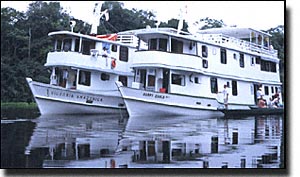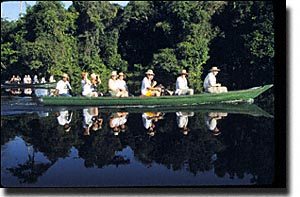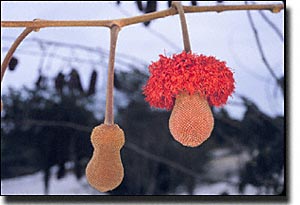
The Amazon:Botany,
Birds, and Bats
Joint Natural History Tour Offered by
The New York Botanical Garden & Bat Conservation
International
September 3-13, 2001
Leaders: Scott Mori, Carol Gracie & John D. Mitchell (NYBG)
Merlin Tuttle & Steve Walker (BCI)
Mario Cohn-Haft (Ornithologist) & Wilson Uieda (Brazilian Mammalogist)
 |
The botany boat will be the Harpy Eagle (right) and
the bat boat
will be the Victoria Amazonica (left). © S. A. Mori,
2001.
|
Since 1987, the New York Botanical Garden has been
leading small, natural history tours to the Brazilian Amazon. Our knowledge
of the flora and fauna of the area, combined with our love of the rain
forest and appreciation for the culture of the caboclo people who
live along the river, permit us to offer a trip unlike any other. Our trips
combine informal natural history instruction with a myriad of other activities
- swimming in the tea-colored waters of the Rio Negro, hiking in the forest,
fishing, early morning birding, nocturnal trips for alligator spotting,
visiting with the local people, occasional cookouts, and a visit to the
famed Opera House and colorful markets in Manaus. We will spend time on
both the Amazon and the Rio Negro and learn about the differences between
the two ecosystems. Our 2001 trip is planned to take advantage of the good
weather of the dry season as the river levels are falling, thus allowing
us to explore some of the rain forest by foot as well as by boat.
As always, we will live and travel aboard small,
but comfortable, Amazonian river boats, both built within the last five
years. The boats, while not luxurious, are air-conditioned and have private
bathrooms in each cabin. In addition, the food is delicious and well-prepared.
The owner/captain of the boats is a legendary Amazon guide who is fluent
in several languages. He enjoys sharing the fascinating, and often humorous,
legends and lore of the Amazon region in which he grew up.
 |
We will make excursions in small, motorized boats.
© C. Gracie, 1991.
|
Dr. Scott Mori and his wife, Carol Gracie, have
extensive research and guiding experience in the tropics and have led 27
previous tours for The New York Botanical Garden. They are the authors
of the Guide to the Vascular Plants of Central French Guiana, among
other publications. Carol and Scott are happy to have their friend and
professional ornithologist, Dr. Mario Cohn-Haft, with them again this year
on the botany/bird boat. Mario recently completed his Ph.D. research in
the evolutionary ecology of Amazonian birds at Louisiana State University.
He now lives in Brazil and is highly skilled in identifying the birds of
the region by sight and sound. Mario has served as an ecotour leader and
lecturer for groups visiting the Brazilian Amazon as well as a guest professor
on the Passport to Knowledge television program, "Live from the Rainforest."
Mario's extensive experience in the Brazilian Amazon has provided him with
an intimate knowledge of the interesting life histories of many of the
birds that we will see. He is associated with Louisiana State University
and INPA, the Brazilian research institution.
This year's trip will be particularly special because
of our collaboration with Bat Conservation International. Bats play an
important role in tropical forests as pollinators of flowers and dispersers
of seeds. These relationships will be discussed as we observe and capture
bats in the evenings. Dr. Merlin Tuttle, Executive Director of Bat Conservation
International in Houston, TX, will head up the "bat boat." Merlin is the
author of several books on bats, an award-winning wildlife photographer,
and a leading conservationist who has studied bats and championed their
preservation for nearly 40 years. A video of his CBS film, The Secret
World of Bats, will be shown on board. Merlin will be accompanied by
Steve Walker from BCI and Brazilian bat scientist, Dr. Wilson Uleda. John
Mitchell, NYBG specialist in the Anacardiaceae (the poison ivy and mango
family) will also travel on the bat boat. John's broad interest in and
knowledge about natural history allows him to speak with authority on the
plants, birds, and bats of the region. He has served as a co-leader with
Scott and Carol on several NYBG tours.
 |
Parkia discolor, a bat-pollinated member of
the mimosoid legume family.
© S. A. Mori, 2001
|
The Brazilian Amazon near Manaus is home to more
than 50 species of bats from eight families ranging in size from the tiny
(3 gram) white-lined bat (Saccopteryx bilineata) to the spectral
false vampire (Vampyrum spectrum) which has a wing span of three
feet! Since bats are nocturnal, few people ever have the chance to see
them at work as they pollinate plants, spread seeds by eating ripe fruit,
or consume up to their body weight in insects each night. By joining NYBG
and BCI on this river adventure, you will have the rare opportunity to
mist net and trap bats with renowned biologist and photographer, Merlin
Tuttle. Most evenings, we will sample the bat fauna hoping to intercept
some of the Amazon wonders such as fisherman bats (Noctilio leporinus),
moustached bats (Pteronotus parnellii), and many of the charismatic
leaf-nosed bats (Phyllostomidae). Dr. Tuttle will point out the special
features of each species, explaining their adaptations and relationships
to other animals and plants of the rain forest.
For additional information, call (718) 817-8647 or email to Carol Gracie
at cgracie@nybg.org.
Art Gallery
Go back to Ecotours


